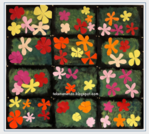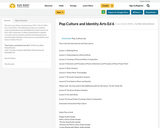
Students will love this pop art lesson that focuses on the principle of movement. It also makes a great abstract portrait that is frame-able!
- Subject:
- Arts Education
- Visual Arts
- Material Type:
- Activity/Lab
- GAP 5
- Date Added:
- 05/18/2021

Students will love this pop art lesson that focuses on the principle of movement. It also makes a great abstract portrait that is frame-able!

In this activity, students create hamburgers inspired by Pop Artist, Claes Oldenburg.

In this lesson, students use pop artist, Roy Lichtenstein's, work for inspiration to create a sunrise painting.

In his lesson, students create pop art-inspired self portraits.
NOTE: You will need an alternate "photo to sketch" website / app than the one mentioned in this lesson. Use the idea presented here for inspiration.

This is a great project for children who are learning about Andy Warhol and the POP Art movement! The bright colors and bold images used in this fun fifties style makes for some stunning creations in your art classroom. Students of all ages can participate with this Andy Warhol art project.

In this Andy Warhol-inspired art project, students attempt to replicate Warhol's original flower artwork.

This unit covers Music strand outcomes CP6.7, 6.8, 6.9, CR6.1, 6.2, 6.3 and CH6.1. The following unit plan was created by Linda Haas (Davidson) and Jade Ballek (Learning Coach) in the 2011-2012 school year. It reflects Saskatchewan's updated curriculum and incorporates authentic learning experiences and technology integration. Assessments are provided for each lesson as well as the unit.

Students design and build paper rockets around film canisters, which serve as engines. An antacid tablet and water are put into each canister, reacting to form carbon dioxide gas, and acting as the pop rocket's propellant. With the lid snapped on, the continuous creation of gas causes pressure to build up until the lid pops off, sending the rocket into the air. The pop rockets demonstrate Newton's third law of motion: for every action, there is an equal and opposite reaction.

Students learn about population density within environments and ecosystems. They determine the density of a population and think about why population density and distribution information is useful to engineers for city planning and design as well as for resource allocation.

Population ecology is the study of groups within a species that interact mostly with each other, and it examines how they live together in one geographic area to understand why these populations are different in one time and place than they are in another. How is that in any way useful to anyone ever? Hank uses the example a of West Nile virus outbreak in Texas to show you in this episode of Crash Course: Ecology.

Hank talks about population genetics, which helps to explain the evolution of populations over time by combing the principles of Mendel and Darwin, and by means of the Hardy-Weinberg equation.

Using Avida-ED freeware, students control a few factors in an environment populated with digital organisms, and then compare how changing these factors affects population growth. They experiment by altering the environment size (similar to what is called carrying capacity, the maximum population size that an environment can normally sustain), the initial organism gestation rate, and the availability of resources. How systems function often depends on many different factors. By altering these factors one at a time, and observing the results, students are able to clearly see the effect of each one.

This lesson is the second of two that explore cellular respiration and population growth in yeasts. In the first lesson, students set up a simple way to indirectly observe and quantify the amount of respiration occurring in yeast-molasses cultures. Based on questions that arose during the first lesson and its associated activity, in this lesson students work in small groups to design experiments that will determine how environmental factors affect yeast population growth.

We’re continuing our unit on health with a discussion of some of the indicators that help us measure health for different populations. We’ll also explore three contributors to health disparities: individual factors like genetics, physical factors like pollution, and social factors like stress.

In which John Green teaches you about population. So, how many people can reasonably live on the Earth? Thomas Malthus got it totally wrong in the 19th century, but for some reason, he keeps coming up when we talk about population. In 1800, the human population of the Earth passed 1 billion, and Thomas Malthus posited that growth had hit its ceiling, and the population would level off and stop growing. He was totally right. Just kidding, he was totally wrong! There are like 7 billion people on the planet now! John will teach a little about how Malthus made his calculations, and explain how Malthus came up with the wrong answer. As is often the case, it has to do with making projections based on faulty assumptions. Man, people do that a lot.

In this task students construct and compare linear and exponential functions and find where the two functions intersect. One purpose of this task is to demonstrate that exponential functions grow faster than linear functions even if the linear function has a higher initial value and even if we increase the slope of the line. This task could be used as an introduction to this idea.

Working in teams, students learn the basics of fluid power design using the PFPD as their investigative platform. They investigate the similarities and differences between using pneumatic and hydraulic power in the PFPD. With the main components of the PFPD already assembled, student groups determine the correct way to connect the valves to the actuators using colored, plastic tubing. Once connected, they compete in timed challenges to test their abilities to separate material out of containers using the PFPDs. NOTE: No special pre-requisite knowledge is required for students to be successful in this activity.

Students investigate the accuracy of sundials and the discrepancy that lies between "real time" and "clock time." They track the position of the sun during the course of a relatively short period of time as they make a shadow plot, a horizontal sundial, and a diptych sundial. (The activity may be abridged to include only one or two of the different sundials, instead of all three.)

Students follow the steps of the engineering design process while learning more about assistive devices and biomedical engineering applied to basic structural engineering concepts. Their engineering challenge is to design, build and test small-scale portable wheelchair ramp prototypes for fictional clients. They identify suitable materials and demonstrate two methods of representing design solutions (scale drawings and simple models or classroom prototypes). Students test the ramp prototypes using a weighted bucket; successful prototypes meet all the student-generated design requirements, including support of a predetermined weight.

Engage middle school students in a meaningful study of the lives of students from across the globe through the use of contemporary nonfiction and fiction. Students create personal autobiographies, sequence story events, and prepare well-crafted summaries while learning to use higher-level comprehension strategies such as Question-Answer Relationships and the Bio-Cube. Additionally, students conduct a critical study of the NCSS Notable Tradebook Nasreen̍s Secret School: A True Story From Afghanistan by Jeanette Winter, comparing and contrasting their own lives to Nasreen̍s and expanding their geographical knowledge of the Middle East.